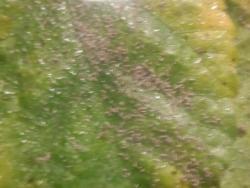Hi Genny, and welcome to ATP. Let's hope we can help you here.
Your pictures are plenty fuzzy, but at least in the second one, the larger black bug with the orange markings is a ladybug larva which is eating the bad bugs! Encourage it, don't squish it. Rescue it if you can before you treat the plant.
The small bugs, honestly don't know, maybe a type of mites. But they're definitely a sucking insect of some sort. Your first clue was the sticky stuff on the leaves early on in the program. That is never a good sign. It is known as "honeydew" but is the droppings of small sucking insects.
If there's any way you could take it into a shower or bathtub and give it a good hosing down with lukewarm water, that would be a first line of defence. It will wash off a good number of the bugs, and give the plant a much-needed respite.
Next, I'd try the soapy water spray, 1/2tsp. of dish soap to a quart of water, and make sure to spray every surface of the plant - backs of leaves, stems, soil surface, the edges of the pot, everywhere there could be little bugs lurking. If you can do this while it is in the shower stall or bathtub, (or outside on a warm day??) that will enable you to go crazy with the spray and really get it covered well.
Then you need to repeat the soapy water spray in a week or so. There will be eggs in the nooks and crannies of the plant that will hatch and start your problems all over again if you don't re-spray.
Then, as a preventative, the DE powder, used dry, will kill off any stray bugs of other kinds. It's not acceptable to use DE outside in the garden, as it kills beneficial bugs like bees and ladybugs as well as bad ones. But indoors, it is a great preventive measure. DE is not a chemical, it is the shells of microscopic creatures which are like tiny shards of broken glass. They abrade the bodies of bugs, slugs and snails, and cause them to die of dehydration.

